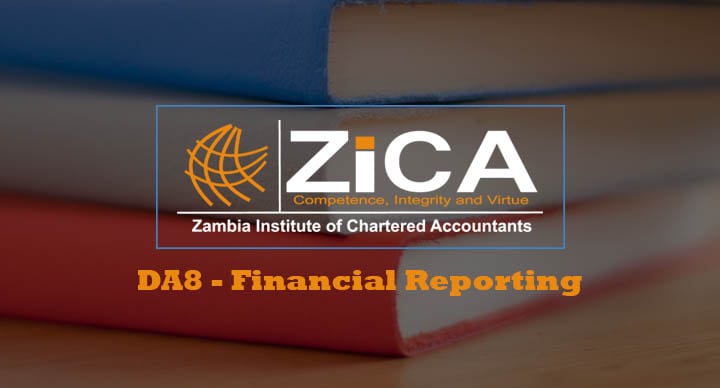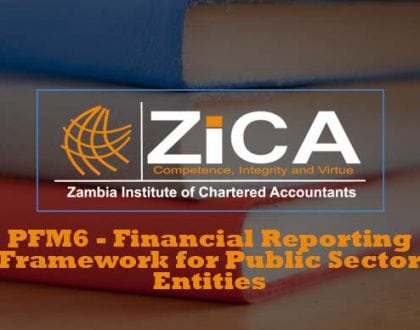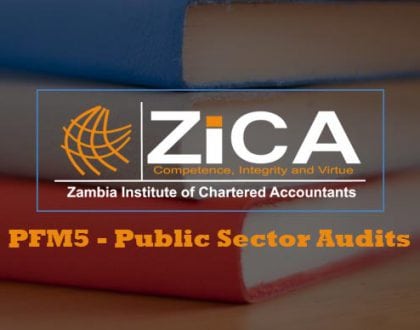DA8-Financial Reporting
No access plans exist.

Course Features
Course Details
DA8-Financial Reporting
Learning outcomes
On successful completion of D8, students should be able to:- Describe the conceptual and regulatory framework for financial reporting and apply the principles set out in the International Accounting Standards Board (IASB) Framework
- Prepare single entity financial statements which comply with International Financial Reporting Standards (IFRS)
- Analyse the information in published financial statements for performance reporting
- Acquire basic understanding of how to prepare group financial statements which comply with IFRS
- Identify the issues involved in preparing financial statements for specialised and public sector entities
| Topic | Weighting |
| The conceptual and regulatory framework | 10% |
| Single Entity Financial statements | 35% |
| Financial analysis and forecasting | 20% |
| Group financial statements | 25% |
| Financial Statements for Public sector entities | 10% |
Content
- The conceptual and regulatory framework
- The conceptual framework
- Describe what is meant by conceptual framework for financial reporting
- Explain the purpose of a conceptual Framework of accounting
- Describe the qualitative characteristics of financial information including the application to the preparation of financial statements.
- Faithful representation
- Relevance
- Comparability
- Understandability
- Verifiability
- Timeliness
- Explain the principle comparability in accounting for changes in accounting policy
- Explain the importance of timeliness and comparability to users of financial statements.
- Explain the recognition and measurement criteria for elements of financial statements.
- Apply the recognition and measurement criteria contained in the Conceptual Framework to assets, liabilities, income and expenses
- Calculate values of elements of financial statements using the following measures:
- Historical cost
- Current cost
- Net realizable value
- Present value of future cash flows
- Fair value
- Explain how the use of current value accounting overcomes the problems of historical cost accounting
- Explain the concept of financial and physical capital maintenance and how it affects determination of profits
- The regulatory framework: IASB structure, global harmonisation
- Explain why a regulatory framework is needed including the advantages and disadvantages of IFRS over national regulation
- Explain why accounting standards on their own are not a complete regulatory framework
- Distinguish between a principles based and a rules based framework and explain how they complement each other
- Describe the structure and objectives of the IASB and the other bodies involved in formulating IFRSs
- Describe the IASB’s standard setting process including revisions and interpretations of standards
- Explain the relationship between the IASB and national standard setters
- Outline the current progress of international harmonisation of accounting standards
- The conceptual framework
-
Single Entity Financial statements
- Presentation of financial statements (IAS 1) (A)
- Illustrate the formats and content of published financial statements presented under IFRS
- Prepare the statements of an individual entity in accordance with IFRS
- Statement of Profit or loss
- Statement of Financial Position
- Statement of Cash flows
- Statement of changes in equity
- Explain the content and purpose of each of the above financial statements
- Tangible Non-current assets (IAS 16, 23 and 40)
- Define tangible non-current assets
- Identify the components of cost of a tangible non-current assets, including subsequent expenditure that may be capitalised
- Define and compute initial measurement of non-current asset (acquired and constructed)
- Distinguish between capital and revenue items
- Discuss the requirements of relevant accounting standards in relation to revaluation of non-current assets
- Account for revaluations and disposal gains and losses for non-current assets
- Account for the revaluation and disposal of items of property, plant and equipment
- Discuss the treatment of investment property and explain why it should differ from the treatment of other tangible non-current assets
- Apply the requirements of IAS 40 to accounting for investment property
- Intangible assets (IAS 38 and IFRS 3)
- Describe the criteria for the recognition of intangible assets
- Discuss the nature and accounting treatment of internally generated and purchased intangibles
- Describe the criteria for the initial and subsequent measurement of intangible assets
- Indicate why the value of purchase consideration for an investment may be less than the acquired identifiable net assets and how the difference should be accounted for.
- Apply the requirement of relevant accounting standard to research and development expenditure
- Distinguish between goodwill and other intangible assets
- Describe how goodwill arises and its accounting treatment IFRS
- Apply amortization and impairment losses to relevant intangibles
- Impairment of assets (IAS 36 and IFRS 3)
- Define an impairment loss and identify the circumstances which indicate that an impairment may have taken place
- Describe what is meant by a cash generating unit
- Apply the correct accounting treatment to an impairment loss for an individual asset or a cash generating unit
- State the basis for allocating impairment losses and allocate impairment loss to assets of a cash generating unit
- Reporting financial performance (IAS 8, IAS 20, IFRS 5 and IFRS 15)
- Distinguish between changes in accounting policies and changes in accounting estimates
- Account for changes in accounting policies, changes in estimates and the correction of prior period errors
- Define government grants and distinguish between income related and asset related government grants
- Account for income related and asset related government grants including the recognition criteria for government grants
- Explain the accounting treatment for repayment of government grants
- Define and account for non-current assets held for sale and discontinued operations
- Explain why it is important to separately identify the results of discontinued operations
- Define and account for non-current assets held for sale and discontinued operation
- Indicate circumstances where separate disclosure of material items of income and expense is required
- Describe and apply the requirements of International Financial Reporting Standards on revenue recognition
- Identification of contracts
- Identification of performance obligations
- Determination of transaction price
- Allocation of the price to performance obligations
- Recognition of revenue when performance obligations are satisfied
- Explain and apply criteria for recognising revenue when performance obligations are satisfied:
- Over time o At a point in time
- Describe acceptable methods for measuring progress towards complete satisfaction of performance obligation
- Explain and apply the criteria for recognition of contract costs
- Apply principles of recognition of revenue, and specifically account for the following types of transactions:
- Principal versus agent
- Consignments
- Bill and hold arrangements
- Repurchase agreements
- Prepare financial statement extracts for contracts where performance obligations are satisfied over time
- Apply the provisions of relevant accounting standards in relation to accounting for government grants
- Inventories and construction contracts (IAS 2)
- Define and apply the principles of inventory valuations
- Provisions and events after the reporting period (IAS 37 and 10)
- Explain why an accounting standard on provisions was needed
- Identify the circumstances in which provisions are appropriate and apply the correct accounting treatment
- Distinguish between legal and constructive obligation
- Explain how provisions should be measured
- State when provisions may or may not be made
- Define contingent assets and contingent liabilities and explain how they are treatment
- Apply the requirements of international Financial Reporting Standards to warranties, onerous contracts, environmental and similar provisions and restructuring costs
- Identify and account for:
- Warranties/guarantees
- Onerous contracts
- Environmental and similar provisions
- Provisions for future repairs or refurbishments
- Distinguish between adjusting and non-adjusting events after the reporting period and apply the correct accounting treatment
- Identify items requiring separate disclosure, including their accounting treatment
- Accounting for leases (IAS 17) (M)
- Distinguish between a finance lease and an operating lease
- Explain the importance of accounting for finance leases according to their commercial substance
- Describe and apply a method for determining a lease type
- Account for finance and operating leases in the financial statement of the lessee
- Discuss the effects on financial statements of a finance lease being incorrectly treated as an operating lease
- Account for sale and leaseback
- Accounting for taxation (IAS 12)
- Account for current taxation in accordance with international accounting standards
- Explain how taxable and deductible temporary differences arise
- Explain the effect of taxable temporary differences on accounting and taxable profits
- Calculate and account for deferred tax amounts in the financial statements
- Segment reporting (IFRS 8)
- Define a reporting segment
- Explain how the IFRS 8 approach differs from the business and geographical approach under IAS 14
- Prepare a simple segment report in accordance with IFRS 8
- Describe criteria for identifying a reportable segment
- Agriculture (IAS 41) (M)
- Define and measure biological assets
- Apply the requirements of international standards in accounting for agricultural activity
- Statement of cash flows (IAS 7)
- Outline the purpose and objectives of a statement of cash flows
- describe operating, investing and financing activities
- Define cash and cash equivalents
- Prepare a statement of cash flows for a single entity using both the direct and indirect methods
- Explain the benefits of users of a statement of cash flows, including its usefulness in assessing the performance of an entity
- Branch accounting
- Account for the activities of branches where each branch maintains its own distinct accounting records
- Account for activities where head office maintains records for all branches
- Foreign currency translation
- Discuss and distinguish functional currency and presentation currency
- Apply relevant accounting standards for the translation of foreign currency amount at different time periods
- Basic financial instruments
- Explain the need for an accounting standard on financial instruments
- Define financial instruments in terms of financial assets and financial liabilities
- Explain and account for factoring of receivables
- Explain classification and measurement of financial instruments using:
- Amortized cost
- Fair value through other comprehensive income
- Fair value through profit or loss
- Distinguish between debt and equity instruments
- Apply requirement of relevant accounting standard to issue and finance costs of
- Equity
- Redeemable preference shares
- Convertible debts
- Indicate how gains and losses from subsequent measurement of financial instruments will be treated in financial statements
- Presentation of financial statements (IAS 1) (A)
-
Interpretation and analysis
- Earnings per share (IAS 33)
- Compute basic EPS in accordance with international Standards including dealing with changes in capital structure
- Discuss the importance and limitations of EPS as a measure of performance
- Interpretation of financial statements (A)
- Compute and explain ratios assessing profitability, solvency, efficiency and the value of a shareholders investment in the entity
- Illustrate how these are compared with the results of previous periods, the results of other entities and industry average ratios
- Discuss the limitations of financial statement information and ratio analysis in assessing the financial performance of an entity
- Cash forecasts (A)
- Explain importance and uses of cash flow forecasts
- Prepare cash flow forecasts
- Forecast of Financial statements (A)
- Prepare forecast financial statements and apply outcome to appropriate decision making.
- Earnings per share (IAS 33)
-
Group financial statements
- Business combinations (M)
- Define a group, a subsidiary and an associate
- Identify the circumstances in which a group is required to prepare consolidated financial statements and the circumstances under which a group can claim exemptions from this requirement
- Outline the rules on exclusion of a subsidiary from consolidation
- explain why directors may not wish to consolidate a subsidiary and when this is permitted by IFRS and other regulation
- discuss the issues of continuous year ends and uniform accounting policies when preparing group financial statements
- List the contents of a set of group financial statements
- Accounting for subsidiaries (IAS 27, IFRS 3, IFRS 10)
- Apply the basic consolidation procedure, including calculation of non-controlling interest (using proportionate of net assets and fair value methods) in the preparation of group statements of financial position and statement of profit and loss with a single subsidiary
- Apply the required accounting treatment of goodwill, including calculation of goodwill arising on acquisition.
- Accounting for the impairment of goodwill
- Account for the effect on intra-group transactions
- Account for the effects of fair value adjustments
- Accounting for associates and joint ventures (IAS 28 and 31)
- Define joint venture, joint control and significant influence
- Describe the accounting treatment for associates in group financial statements
- Describe different forms of joint ventures including: jointly controlled operation, jointly controlled assets and jointly controlled entities
- Describe accounting treatment involving joint ventures and account for joint venture transactions
- Business combinations (M)
-
Financial statements for public sector entities
- Financial Reporting Framework for public sector entities (M)
- Explain the progress in the development of the conceptual framework for not for profit entities
- Contrast the aims of public sector entities with those of profit making
- International public sector accounting standards (IPSAS)
- Discuss the extent to which International standards are relevant to public sector entities C Preparation of financial statements for public sector entities
- Discuss the content of public sector financial entities in accordance with IPSAS 1
- Outline how the performance of public sector entities can best be measured
- Financial Reporting Framework for public sector entities (M)
Format of the exam
| Section | Marks |
| Section A: 2 compulsory questions, 25 marks each | 50 |
| Section B: Any 2 out of 3 questions, 25 marks each | 50 |
| TOTAL | 100 |
Recommended reading
- ZiCA D8 Study Manual
- 2015 International Financial Reporting Standards, IFRS Foundation Education Initiative
- Dodge, R, Foundations of Business Accounting, 2nd edition, Cengage Learning, 1997
- Dunn, J, Financial Reporting and Analysis, Wiley, 2010
- Elliott, B J and Elliott, J, Financial Accounting and Reporting, 14th edition, FT Prentice Hall, 2010
- Wood, F and Sangster, A, Business Accounting 1, 12th edition, FT Prentice Hall, 2011
This course does not have any sections.





